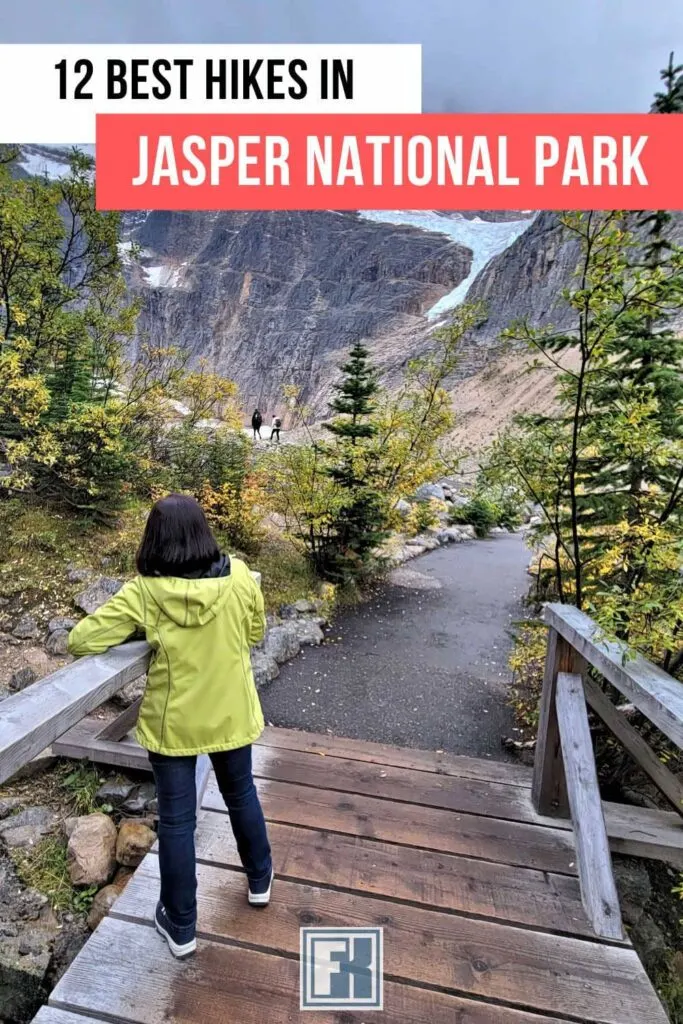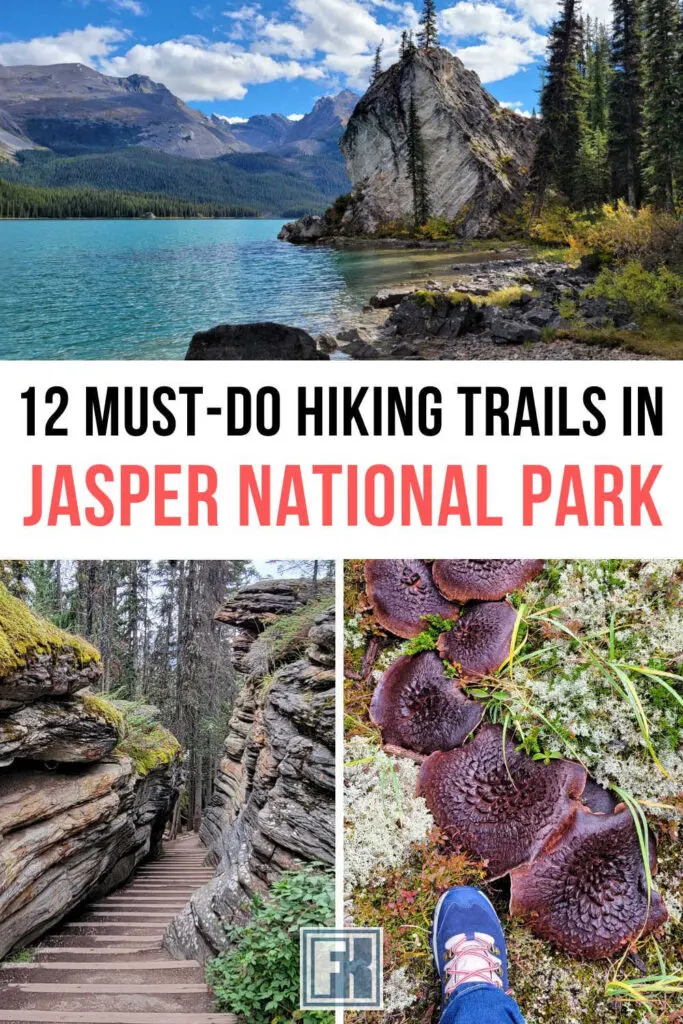
The Canadian Rockies have some of the finest panoramas globally. North of Banff, Jasper National Park sees fewer visitors, and it’s a great place to put on hiking shoes and immerse yourself in the landscape. So, if you’re looking for the best hikes in Jasper, in this article, you’ll find 12 great options.
Jasper’s rugged peaks, turquoise lakes, and rushing waterfalls are jaw-dropping. While the endless landscape has an abundance of hiking trails suited for all fitness levels, these Jasper day hikes and walks are rated easy to moderate.
Established in 1907, Jasper is the largest national park in the Canadian Rockies and provides a similar caliber of scenery to Banff.
Unlike its southern neighbor, Jasper’s highways are unfenced, making animal viewings more common. So, as you explore the alpine meadows and rocky pathways, be on the lookout for wildlife, wildflowers, and feathered friends.
Where To Stay In Jasper National Park
Camping provides an inexpensive option when visiting Jasper in the summer. Jasper campgrounds are plentiful, with Whistlers and Wapiti campgrounds providing the lion’s share of the sites.
Near the Jasper townsite, the Fairmont Jasper Park Lodge has luxury accommodations surrounded by pristine landscapes and a wonderful golf course.
If you want something more budget-friendly, the Mount Robson Inn has a complimentary breakfast. Their rooms have mini-fridges and microwaves too.
Alternatively, the Marmot Lodge offers a quiet location, with a Starbucks and a great restaurant on the property.
Located 6 km from the town of Jasper, the Pyramid Lake Resort offers a chalet-style venue with spectacular mountain views. Open year-round, you can enjoy hiking and canoeing in summer, and snowshoeing, fat biking, and cross-country skiing in winter.
So, if you have a few days in Jasper National Park, check out these easy to moderate hiking trails.
Athabasca Glacier
- Difficulty: Easy | Distance: 1.4 km loop
The Athabasca Glacier, part of the Columbia Icefields, is one of North America’s most accessible Glaciers by vehicle. It’s the ideal halfway stopping point on the Jasper from Banff drive.
I first visited the Icefields in 1983 when I could walk right onto the glacier, which was close to the parking lot. Today much has changed.
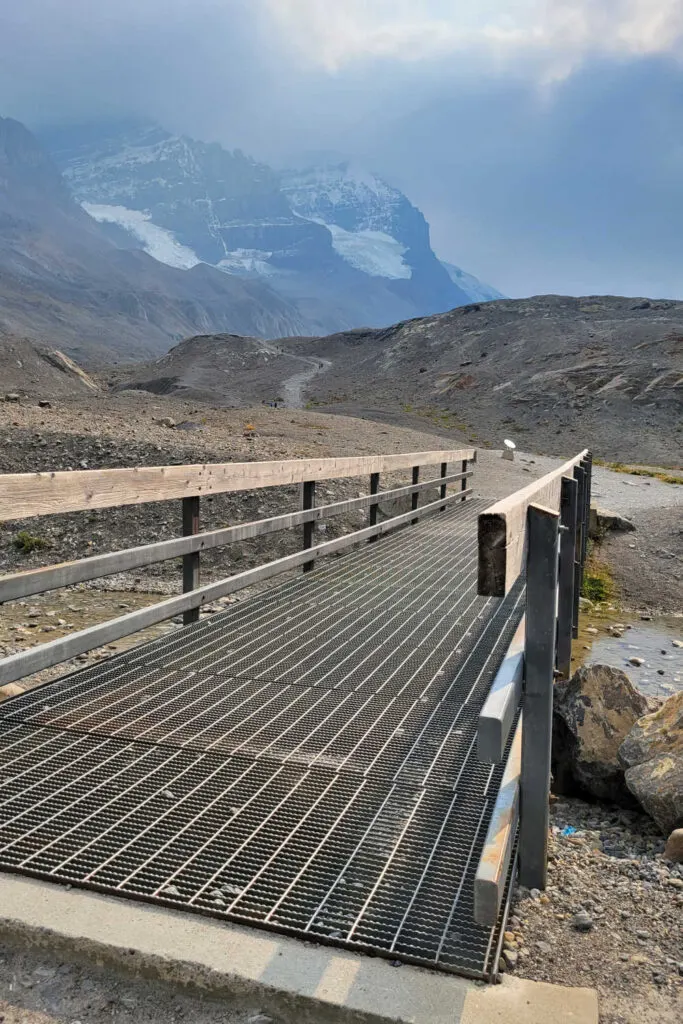
The ice mass has retreated significantly and continues to melt back up to seven meters annually. The glacier is no longer next to the parking area, and visitors cannot walk on the ice.
From the Icefields Parkway, take the exit to the west of the Columbia Icefield Discovery Centre and drive to the parking lot. Bundle up as the glacier acts as a freezer, cooling the winds as they sweep down from the peaks.
Cross a wooden bridge and follow a rocky pathway. While there isn’t a real hiking trail, the path climbs 61 meters and takes an hour but grows longer each year as the ice retreats.
The forefield trail is one the best hikes in Jasper to see a glacier. Along the route, markers indicate where the toe was in preceding years, and it’s astonishing to see the stats.
With a large river flowing from the glacier’s terminus, visitors can’t access the glacier as water and unstable ground block the path.
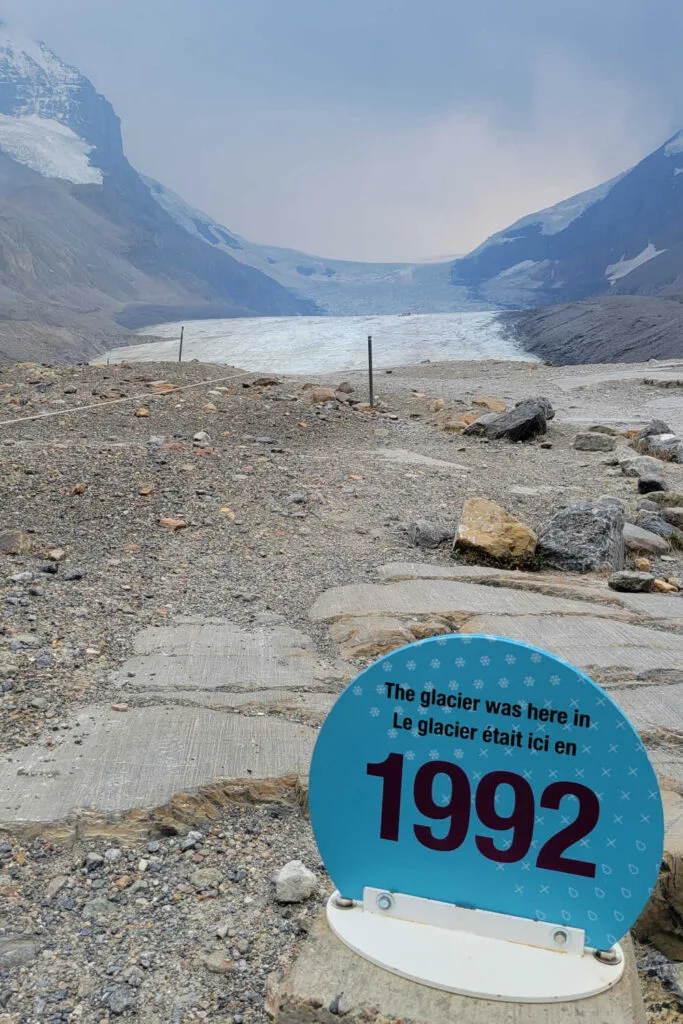
At the end of the trail, stay within the roped area for your own safety. Continue on the looping path before returning to the parking lot.
For those who want to forego the pricey Pursuit bus excursion, the hike to the glacier provides a great alternative and a fantastic way to explore part of the Columbia Icefields.
Should you wish to adventure into the ice, consider booking a Glacier hike with an experienced guide.
Wilcox Pass
- Difficulty: Moderate | Distance: 9 km return
Named after Walter Wilcox, the first explorer to walk these lands, undoubtedly, Wilcox Pass offers one of the best hikes for Columbia Icefields views without walking on it.
I camped at the Wilcox Creek campground (3 km south of the Icefields) to gain early access to this Jasper hike.
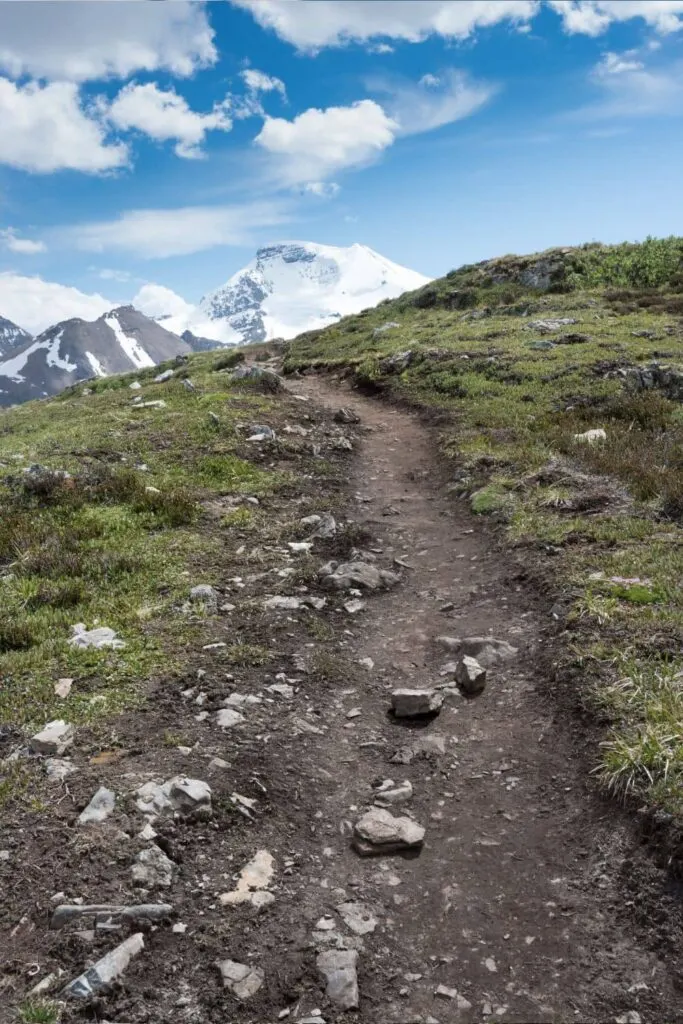
This unserviced Jasper campground has 46 sites and gives easy access to the Columbia Icefields too. Not only did I wake up to snow in July, but it was cold hiking the trail.
The initial part of the hike from the campground rises steeply in an old-growth spruce forest and may discourage some trekkers. With a starting altitude of over 2,000 meters, you may get out of breath quickly, and the thin air makes the ascent challenging.
With an elevation gain of over 500 meters and thinning air, don’t expect to rush the climb. After about 1 km, you can enjoy a rest on the Parks Canada red Adirondack chairs as you enjoy the view of Sunwapta Pass.
Parks Canada has placed these chairs in scenic places throughout national parks. We had taken a selfie sitting in one at Takakkaw Falls, a must-do Yoho hike.
From here, continue on a gentle incline above the treeline, where the frigid winds from the Icefields will chill you to the bone if you haven’t dressed appropriately.
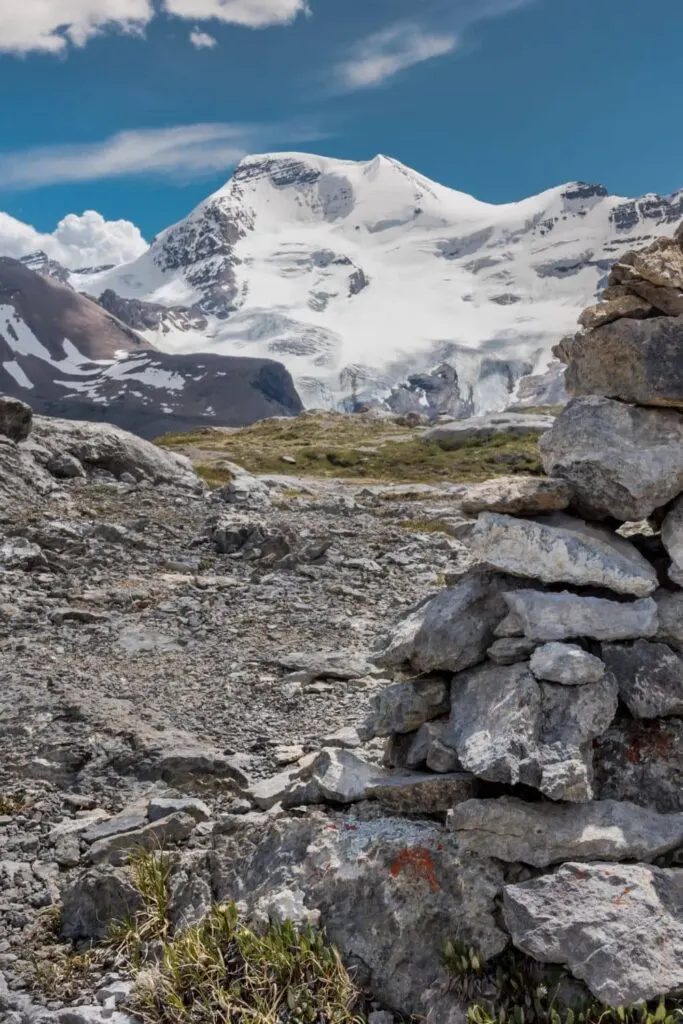
At the Wilcox Pass summit, the views of Mount Athabasca and Snow Dome are astounding. While most hikers don’t linger long, look around, as you may see Bighorn sheep on the ground and golden eagles in the air.
Beware, as grizzly bears also frequent the area. Thankfully, hikers can relax on the return hike as it’s all downhill.
Upper Moose Lake
- Difficulty: Moderate | Distance: 3.5 km loop
In the winter, skiers use the Moose Lake trail for cross-country skiing. However, the Jasper day hike offers a chance to see moose grazing in the marsh near Maligne Lake in the summertime.
Drive to Maligne Lake, pass the first parking area and buildings, and park in the second lot to access the trail. Here, look for the sign for the Moose Lake Loop trail close to the bathrooms.
Walking parallel to Maligne Lake, the trail passes a boat launch and continues hugging the lake’s edge. Five hundred yards in, it reaches a junction where the trail turns into a loop.

We chose to walk the loop counter-clockwise, reaching Moose Lake 700 meters later. The Park maintains this portion of the trail, which is wide and easy to walk.
Reaching Moose Lake, we saw no moose but decided to complete the trail loop. However, those who want a short trail can return on the same route.
From here, the looping trail is unmaintained and resembles more of an animal trail, narrow and muddy in some places. This area stays moist year-round, allowing moss and mushrooms to thrive.
I was astonished to come across one variety, ‘Scaly Hedgehog,’ larger than my boots. After a considerable trek, the trail reaches Maligne Lake, with the balance of the route following the shoreline.
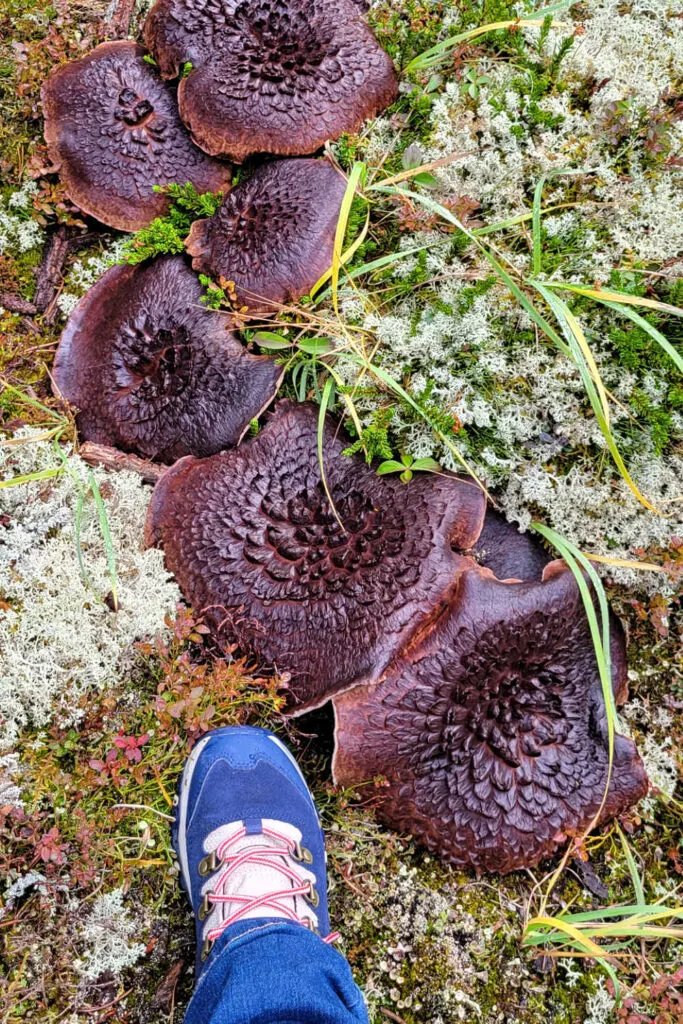
Although relatively flat, this section was hardest to walk due to abundant roots, which created a tripping hazard. In September, the mosquitoes were rampant, and we had to keep moving to prevent bites.
As we walked, I spotted two moose swimming across the lake. Watching intently, we saw a cow moose and her calf exit the lake on the other side.
Valley Of The Five Lakes
- Difficulty: Moderate | Distance: 4.6 km loop
Unlike Moraine Lake and Lake Louise, which are glacier-fed Banff lakes, the Valley of the Five Lakes features small tarns. However, they still radiate with striking shades of turquoise and aquamarine due to the rock flour and algae in the water.
Situated close together, this one 5-for-1 hike, while not difficult, has some up and down sections. Hikers can choose to hike clockwise, seeing lakes one to five, or counter-clockwise. The looping trail travels between lakes one and two and continues along the third lake.
It passes between lakes four and five for the return hike. On a hot summer day, consider taking a bathing suit because the small ponds are much warmer than their larger glacier-fed cousins.
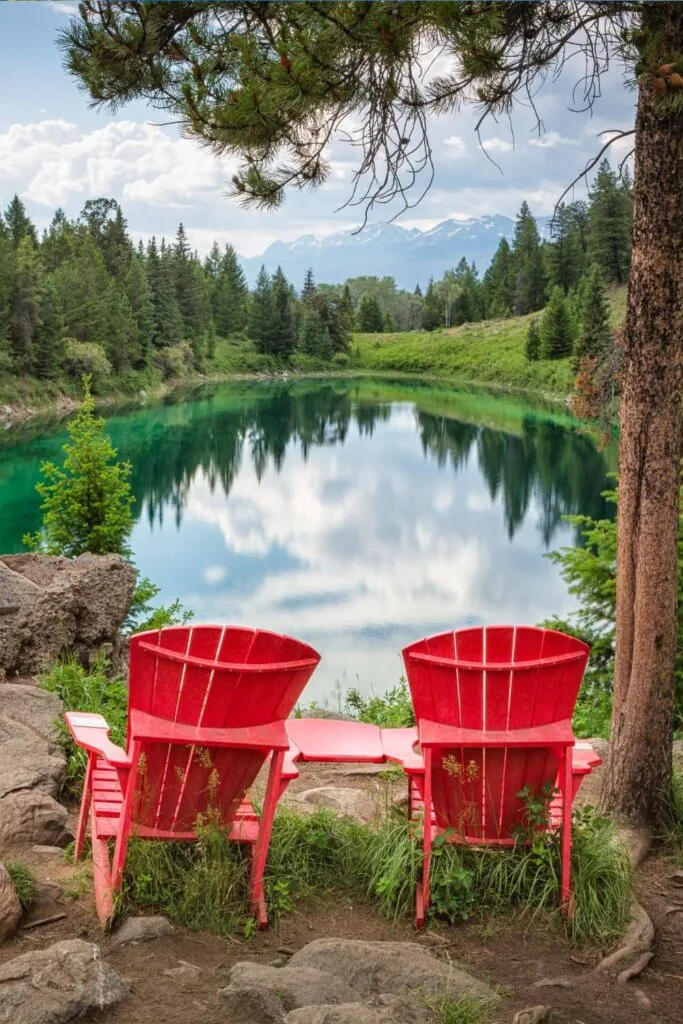
Should you want to explore the first lake, hikers can take a longer trail that circumnavigates the bigger lake. During the hike, you’ll pass beaver dams and have an opportunity to see their creative builders. Also, deer, elk, coyote, and black bears frequent this valley.
Expect moderate traffic on the trail during the busy summer months. Of the five lakes, the second pales in comparison to the others, but lakes three through five astound visitors with their crystal-clear waters, vibrant tones, and mirror reflections.
Next to one of the lakes, you’ll find a set of red chairs. These iconic Adirondack chairs are shattered throughout the Canadian Rockies and beg for a selfie.
Stanley Falls
- Difficulty: Easy | Distance: 3.2 km return
If you love chasing waterfalls, then the scenic Stanley Falls hike is a must. The hardest part of the adventure was finding the small parking lot located 2 km south of Beauty Creek Hostel.
I first hiked this trail in the 1990s when few people knew of its location. Today, it’s still an unknown hike, but it’s a great alternative to the overcrowded Johnston Canyon in Banff National Park.
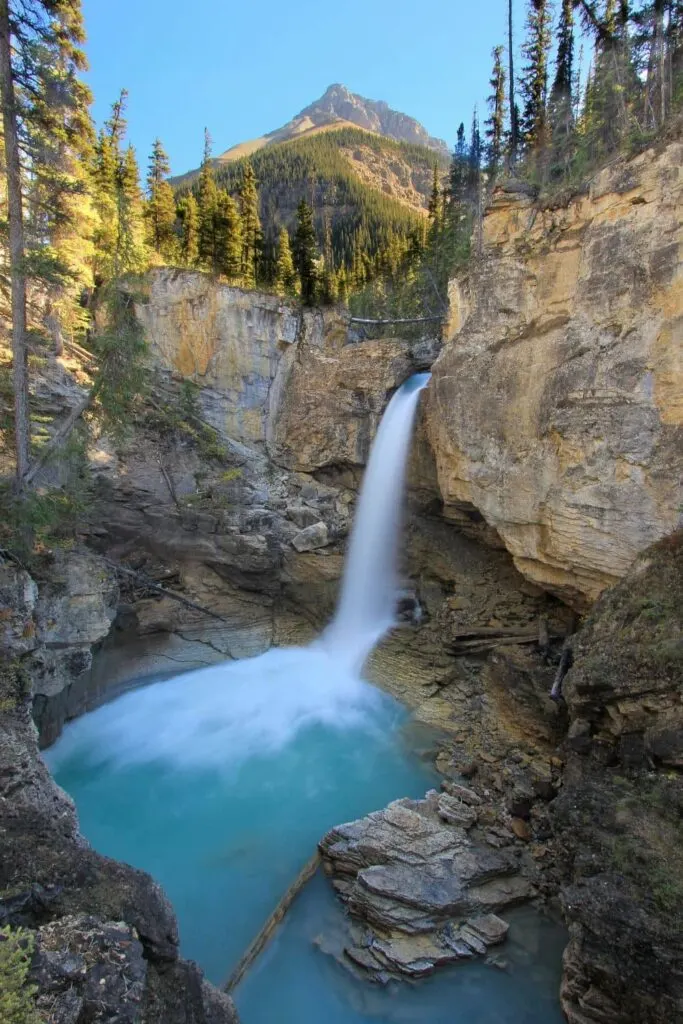
The trail starts across Beauty Flats until it turns right onto an old road. At the collapsed bridge over the creek, veer left where the trail follows the left side of Beauty Creek. Along the way, hikers enjoy about ten picturesque waterfalls and the sounds of rushing water.
Although not marked, you’ll eventually arrive at the last, Stanley Falls. It’s important to note that since this trail is not well-traveled and unmaintained, it has no guard rails or signage on the route. So, exercise caution when trying to view the falls.
Since this is bear country with few hikers, it’s best not to hike alone, carry bear spray (and know how to use it), make noise, or take a bear bell.
Being so picturesque, I have to wonder if Beauty Creek will become another Johnston Canyon. So, enjoy the peacefulness of the Stanley Falls hike before its discovered by others.
Path Of The Glacier Trail
- Difficulty: Easy | Distance: 1.6 km loop
I felt a connection to Edith Cavell on my first visit, and it still astounds me today. Less visited than its more famous attractions to the south, Edith Cavell offers a chance for solitude.
At 3,363 meters, on a clear day, its prominent peak is visible from Jasper town.
Named after a British nurse who helped hundreds of soldiers escape during World War I, she was executed for her crimes. Later, her body was interned at England’s Norwich Cathedral.
The drive to the parking area has switchbacks with some very narrow sections, not accessible to large RVs. Drive slowly and enjoy the scenery and views of Mount Edith Cavell.
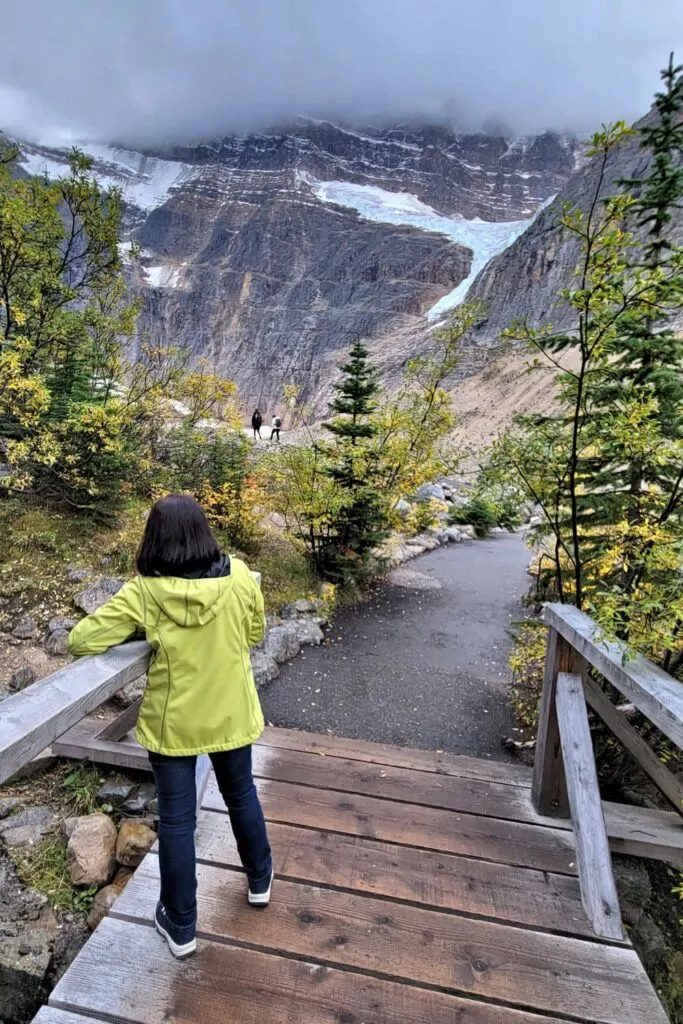
From the parking lot, the paved path climbs along the moraine, crosses a stream, and continues on a rocky path. With every footstep on the easy trail, you’ll get better views of the glacier and Cavell Pond.
Beneath its towering peak, ‘Angel Glacier,’ so-called because of its shape, hangs gracefully above Cavell Pond. Like the glacier at the Icefields, Angel Glacier has retreated quite a bit and looks less like an angel each year.
At the viewpoint, listen for sounds of thunder as the glacier cracks and calves into the water below. Huge icebergs that have fallen from the glacier often embellish the chilly mint-green waters below.
In 2012, 70% of Ghost Glacier to the left of Angel Glacier collapsed into the pond, creating a surge of water flowing down the valley. It flooded the parking lot, wiped out the trail to Cavell Lake, and caused widespread damage.
Today, a roped area prevents visitors from accessing the pond in case of another glacier collapse.
Edith Cavell Meadows
- Difficulty: Moderate | Distance: 8.4 km loop
The Cavell Meadows hike gives a different perspective of Angel Glacier for those who can’t get enough of Edith Cavell. While the trail has almost a 600-meter elevation gain, hikers don’t need to walk the whole loop since visitors can enjoy the jaw-dropping scenery throughout the trail.
The start of this trail shares the same path as the Path of the Glacier (above). Shortly after, it veers off before climbing steeply on a rocky moraine.
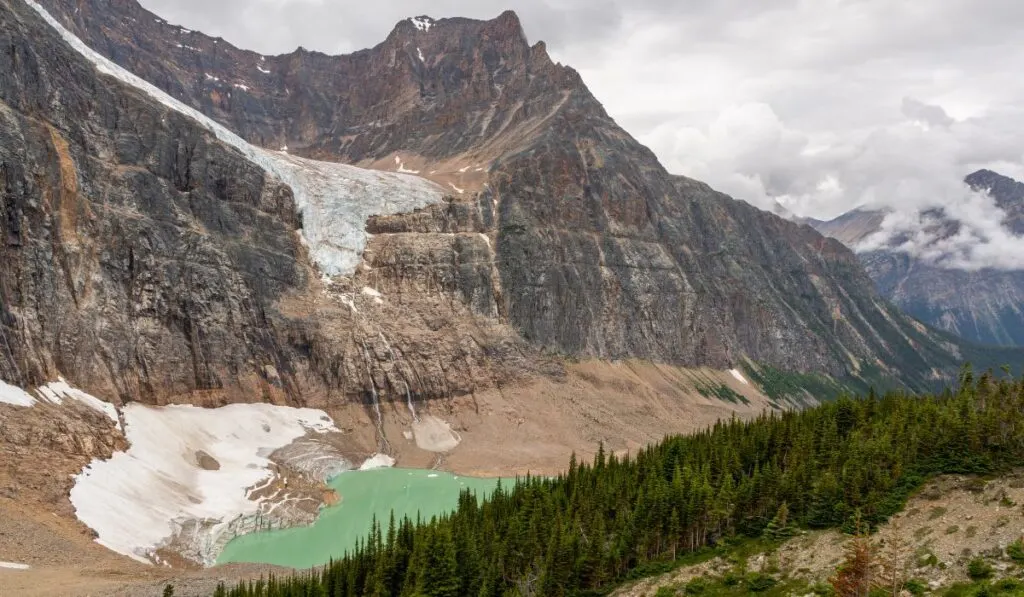
On this moderate trail, you may spot pika or hoary marmots who inhabit this area. The marmots are cute characters who love to stretch out on rocks to soak up the sun.
Soon, you’ll be in a subalpine forest of mainly fir and spruce. A few kilometers into the hike, the tree line dissipates before eventually becoming a meadow. In July and August, it’s the perfect place to see wildflowers adding color to the surrounding landscape.
As you climb, remember to look back because the views of the mountain peaks and glaciers will knock your socks off.
Near the top, the trail divides to create a loop. This section of the trail is very steep, so do not attempt it if it’s beyond your capability.
At the beginning and end of the season, snow may cover the path, so bring crampons and hiking poles to aid in the climb. Since the Edith Cavell Meadows is a caribou habitat, a species-at-risk, hikers cannot bring dogs on the trail.
Maligne Canyon
- Difficulty: Moderate | Distance: 6.8 km loop
Maligne Canyon is Jasper’s most accessible canyon and popular hike. It offers hikers many choices of how to enjoy it. With three parking lots, visitors have a variety of hiking options.
They can choose to hike from bridges one to six or travel in the opposite direction, traversing the uphill sections at the beginning. Alternatively, hikers can choose from the following options from the Maligne Canyon Wilderness Kitchen parking lot.
| Bridges 1 and 2 | Easiest hike | Takes 20 mins |
| Bridges 1 thru 3 | Easy hike | Takes 40 mins |
| Bridges 1 thru 4 | Slightly harder hike | Takes 1 hour |
| Bridges 1 thru 5 (can also hike 5 thru 1) | Harder hike | Takes up to 2 hours |
| Bridges 1 thru 6 ( can also hike 6 thru 1) | Hardest hike | Takes up to 3 hours |
Those wanting to see all six bridges without hiking the 6.8 km trail can hike from bridges 1 to 4 and drive to see the other two bridges. The more manageable sections are heavily trafficked, but the crowds dissipate as you walk further.
We hiked from the deepest part of the canyon downwards. Maybe not the smartest option since we had the uphill section at the end of our trek.
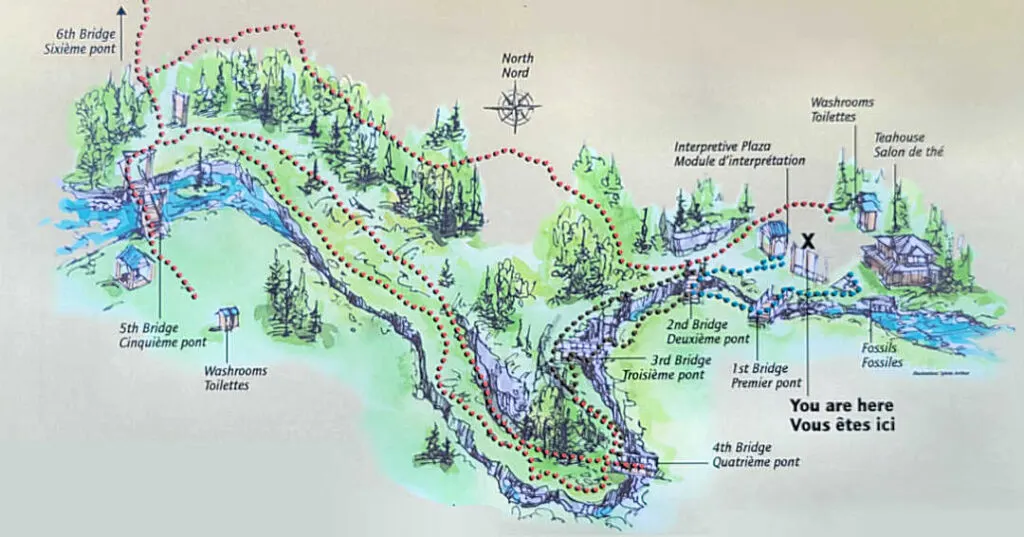
It was hard to see the water at some points, but we could hear it raging below. Water dissolving softer rocks such as limestone and dolomite produced Maligne Canyon’s interesting karst system.
As one of Jasper’s best day hikes, you’ll view a canyon of caves, sinkholes, disappearing streams, and underground springs. Further down the river, cascading waterfalls add to the itinerary.
The first bridge has a lovely waterfall, and the second bridge offers the deepest views at 51 meters over the river. Here, I saw a chockstone or large boulder wedged near the top of the narrow canyon.

The fenced trail follows the canyon and consists of some paved sections and dirt paths. At the third bridge, the river widens slightly, and I could see how the water has created potholes in the rocks.
Just past the fourth bridge, I saw underground water from Medicine Lake feeding into the river. From here, it seemed like a long trek to the fifth bridge, and the path became muddy at some points.
The fifth bridge, a new suspension bridge, crosses the widened Maligne River and leads to the lower parking lot, picnic area, and outhouses. This is a great place to enjoy a break and a snack before heading onward.
There are more opportunities to view underground waterways as you trek through a forest of mainly fir trees from the fifth bridge to the sixth bridge. We followed the same path on the return route but took the left trail at the fork near the fifth bridge.
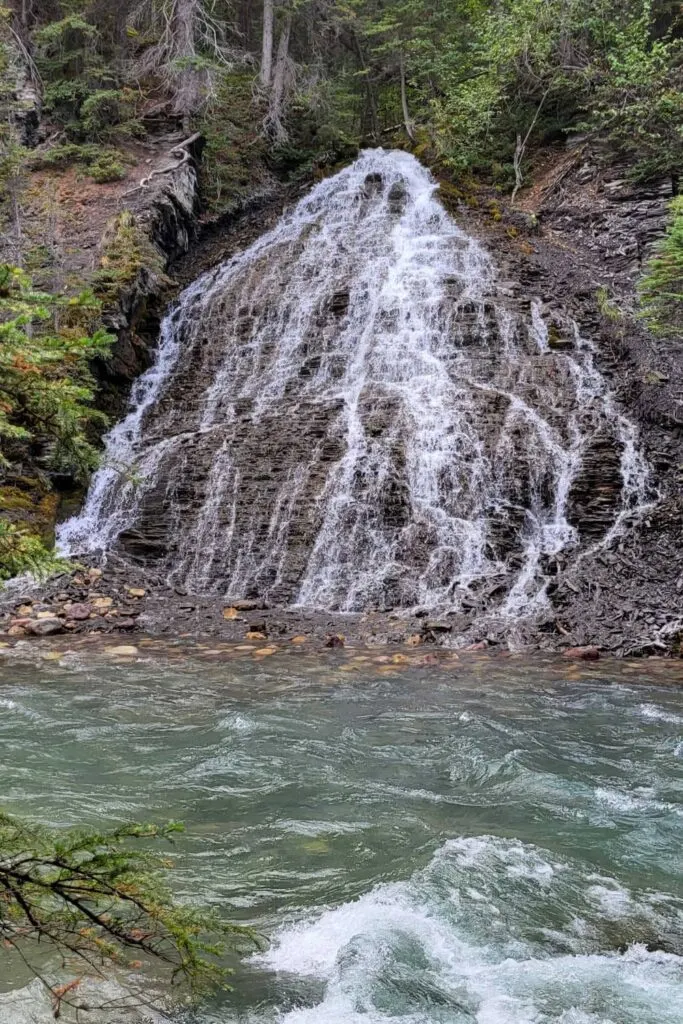
This alternative pathway goes further up the mountain through a meadow. Although uphill, the route was more direct, easier than the canyon pathway, and had virtually no people.
If you finish you hike at the upper parking lot, treat yourself to a meal at the Maligne Canyon Wilderness Kitchen. This smokehouse eatery is a top restaurant in Jasper, and offers both indoor and outdoor seating.
Old Fort Point
- Difficulty: Moderate | Distance: 3.7 km loop
If you’re looking for aerial views of Athabasca Valley that cost you nothing, then hike the Old Fort Point Trail. Located close to Jasper townsite, the heavily trafficked trail is dog friendly and gets your heart racing. Hikers have options to do the looping trail in either direction.
However, if you trek clockwise, you’ll experience the steepest section going downhill at the end. Some only go for the view and hike counter-clockwise and do not complete the loop.
Walking clockwise, I started the trail with a leisurely stroll through a pine forest. It gradually ascends before reaching a steep section. Then, the trail loops back and opens up to offer amazing views of the surrounding terrain.
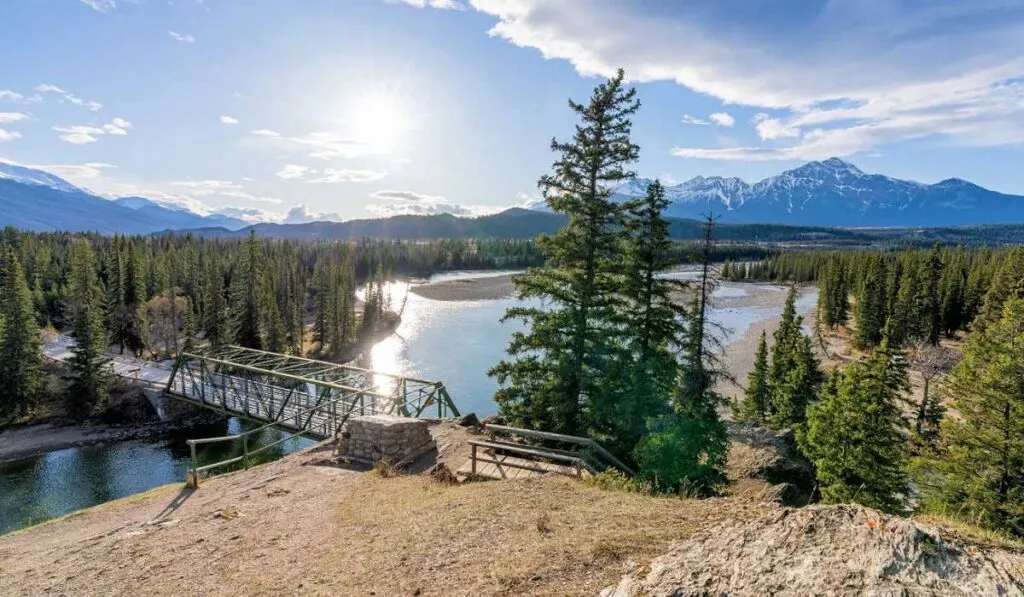
The path continues into the forest before reaching a giant rock viewpoint. Here, the climb rewards you with fantastic 360-degree panoramas of the Miette and Athabasca Valleys. During the hike, watch out for Bighorn sheep and grizzly bears who frequent the area.
After spending some time at the summit, head down on the steep trail. Be careful, as some sections have loose rocks and gravel. Once you walk down a set of wooden stairs, the trail flattens out for the rest of the trek.
Athabasca Falls
- Difficulty: Easy | Distance: 1 km
While not a hike but a walk around a roadside attraction, Athabasca Falls should not be missed when visiting Jasper National Park. At almost 50 meters wide, the memorable waterfall captivates travelers with its thunderous volume of water falling into a gorge.
Depending on when you visit, the water can vary in color. During my last trip, the water was pale green, created from the fine silt from melting glaciers. Another time, I witnessed the falls roaring a muddy torrent.
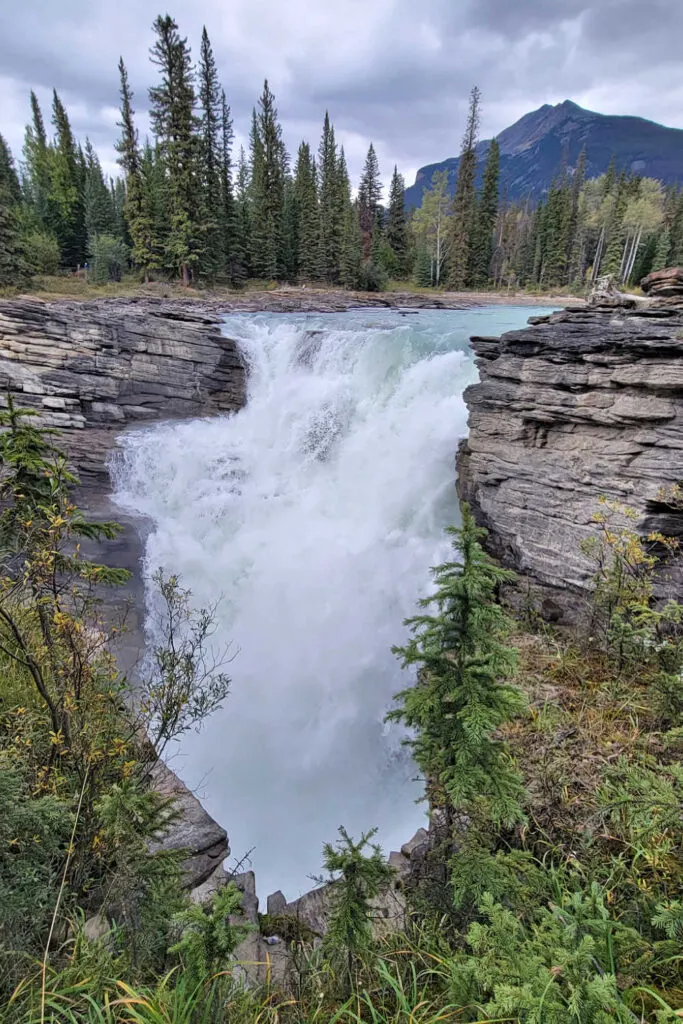
The water in the Athabasca River originates from the Columbia Icefields. From the falls, it continues on a 6200 km journey to Great Slave Lake and Mackenzie River before flowing into the Arctic Ocean.
At Athabasca Falls, there are plenty of photo opportunities from the bridge and numerous viewpoints on both sides of the river. Be sure to walk down the stairs through an ancient canyon where the water once flowed.
At the bottom of the stairs and to your left, visitors can view a giant pothole created by the water. Following another staircase down, you’ll arrive at the river’s edge, now wide and no longer in rage mode.
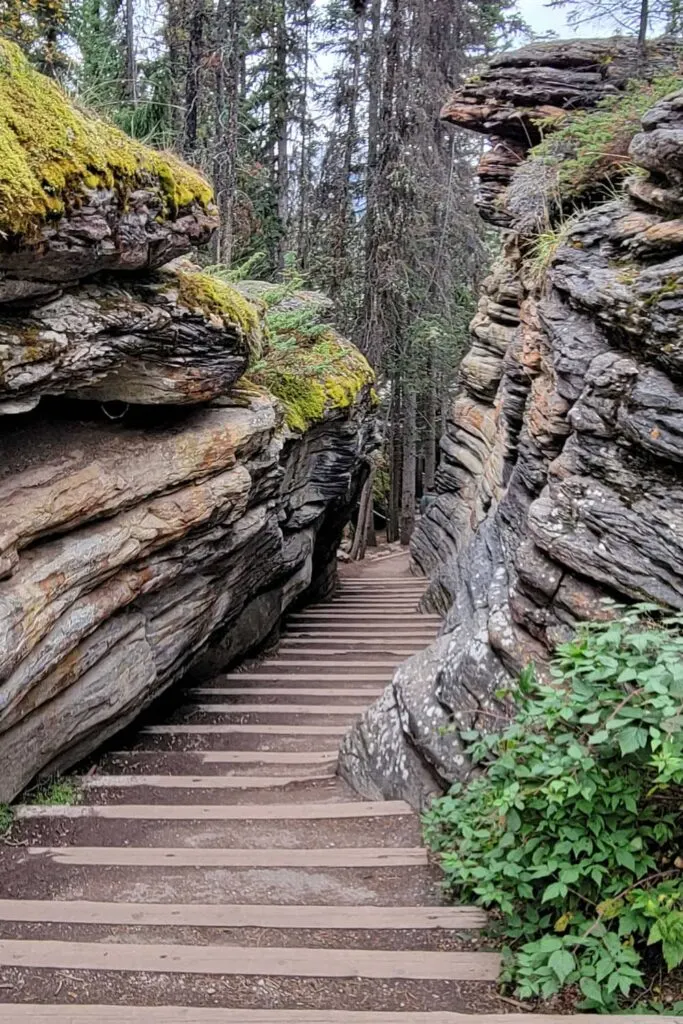
Every few years, someone dies at the falls when they venture past the safety fencing in an attempt to capture a better picture. As the sign at the falls says, “step off the trail, and you risk your life.” Don’t be that person.
Lake Annette Loop
- Difficulty: Easy | Distance: 2.7 km
Take a scenic lakeshore hike on Lake Annette’s loop trail in the heart of Jasper. Lake Annette is a kettle lake fed by an underground water source from Medicine Lake.
Since it’s not a glacier-fed lake, its warmer blue-green waters are ideal for swimming in the heat of the summer.
Suitable for all levels of hiking ability, this well-marked, paved path offers one of the best easy hikes in Jasper. The trail features numerous displays that name the surrounding mountains.
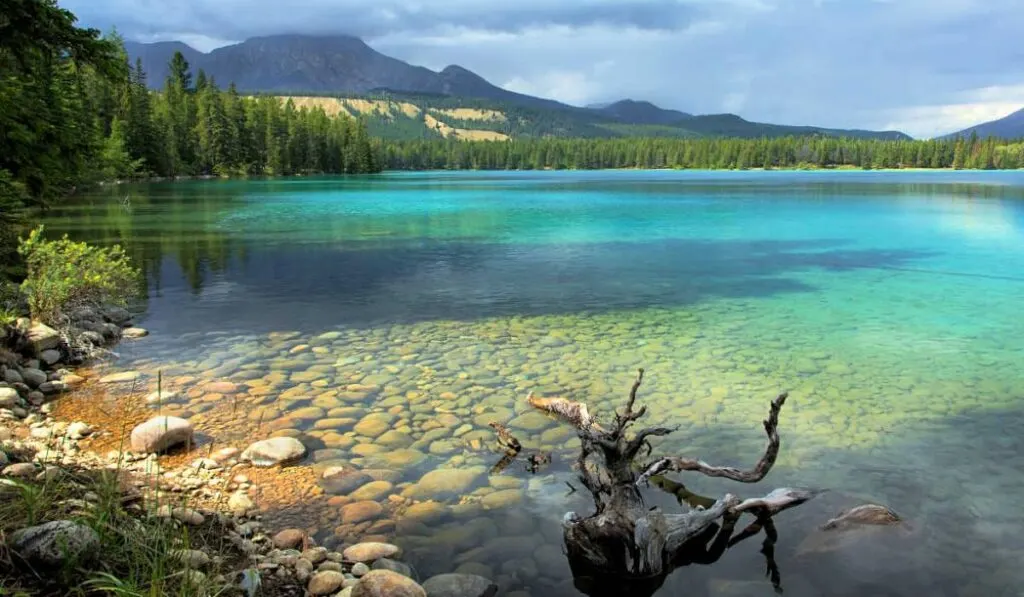
Although the trail is doable for those with wheelchairs, there is a hill at one point that may be difficult to maneuver.
The path past the lake has informational displays that name the nearby mountains, providing lovely views from its hill. This beginner-friendly loop provides opportunities to observe unique glacial lakes.
While getting acquainted with its beautiful mountain surroundings, you’ll get a quick introduction to local rock formations too.
Beauvert Lake Loop Trail
- Difficulty: Easy | Distance: 5.3 km
If you’re visiting or staying at the Fairmont Jasper Park Lodge, the 5.3 km Beauvert Lake loop trail should be at the top of your list! Start at the Old Fort Pt Road access and journey counter-clockwise around the lake.
The first 300 meters meander through the woods, but when you reach the lake shore, you’ll enjoy stunning views of Pyramid Mountain and the historic grounds of Fairmont Jasper Park Lodge.
Follow the shore through its horseshoe shape before heading south to complete a loop back at Old Fort Pt Rd. The looping trail is flat, relatively easy, and allows you to explore this stunning turquoise lake from a whole new angle.
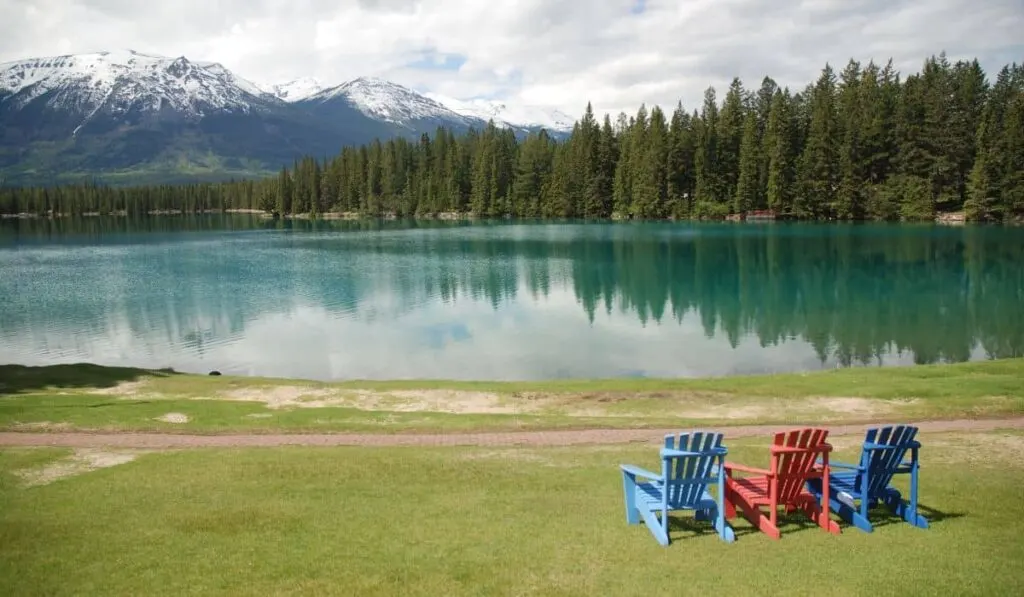
With its location by the Jasper lodge, it’s an ideal hiking option for those without a car. During the hike, it’s not unusual to encounter elk and be serenaded by the sounds of loons.
If you’re visiting in May, sections of the trail may be closed to elk calving. Stay clear of elk with new calves, as they can be quite aggressive.
Jasper Hiking Tips
Any time you venture out on a trail, you’re in bear country. Exercise caution by not traveling alone, having a bear bell or making noise, and carrying bear spray that’s easily accessible. Bring plenty of water and protein snacks in a waterproof backpack.
Check on the forecast before heading out and dress for the weather conditions.
The use of hiking poles saves your knees on some trails.
Take out what you took in.
Wear good hiking boots with wool hiking socks.
Check on the condition of the trail first.
Don’t wander off the trail.
Don’t remove plants, fossils, or rocks.
Hike in a group if it’s required.
Don’t take your dog on a trail where dogs are not allowed.
Final Thoughts
While both Banff and Jasper are comparable national parks, Jasper sees fewer visitors. Maybe because it’s further north, or perhaps it doesn’t contain the iconic Lake Louise or Moraine Lake images scattered on the web.
Whatever the reason, you can enjoy the town without traffic congestion, hike with fewer people, and have a greater opportunity to view its wildlife.
Jasper, like Banff, is a year-round destination. While some areas like Edith Cavell close to vehicle traffic, you can still enjoy many trails with the aid of snowshoes or crampons.
For hiking enthusiasts, Jasper has over 1,200 kilometers of hiking trails. While the ones listed above are easier and shorter, hiking enthusiasts can enjoy longer, more challenging overnight treks.
Happy travels ~ Karen

